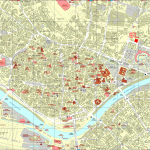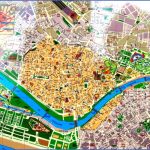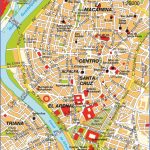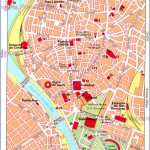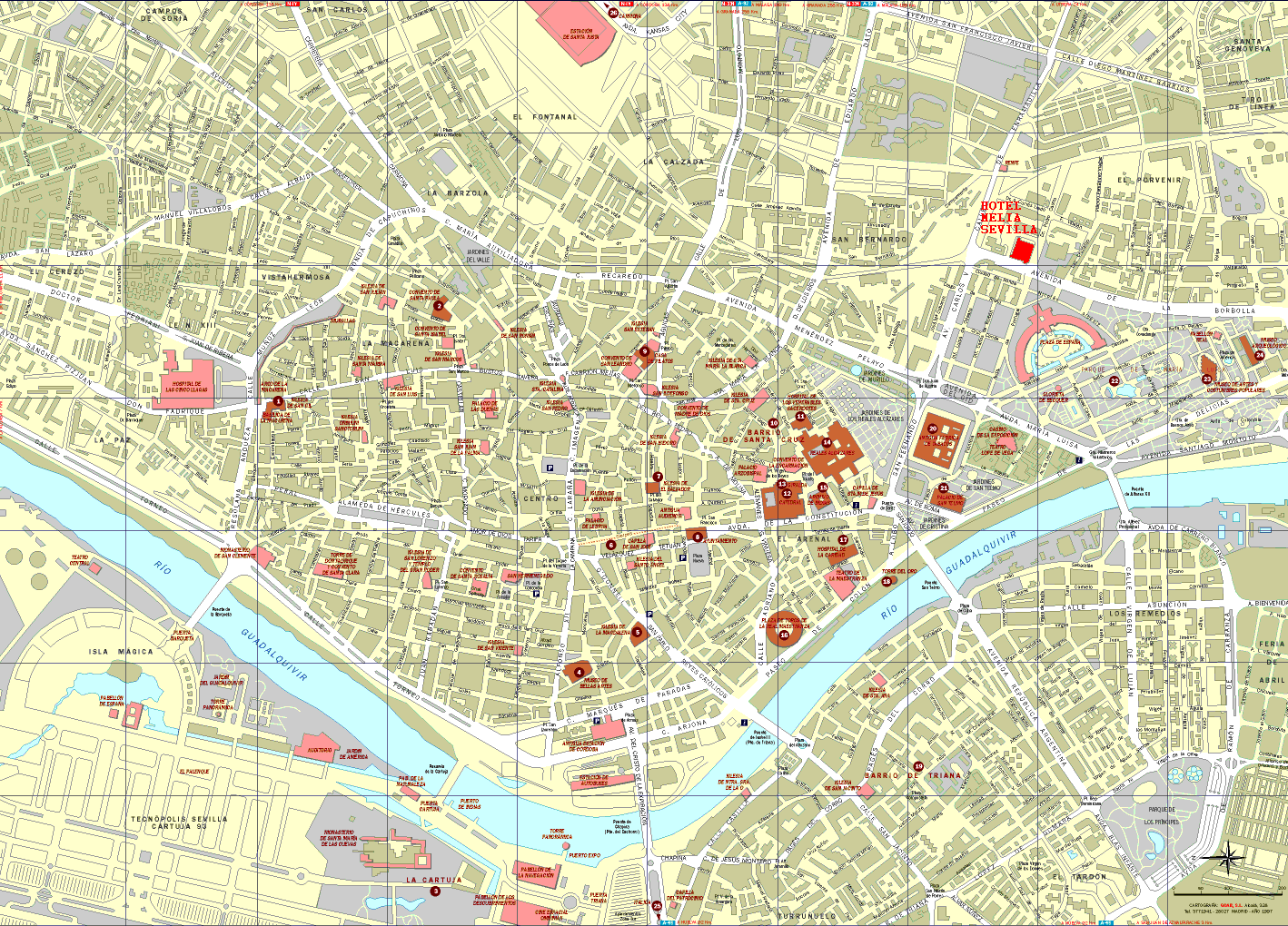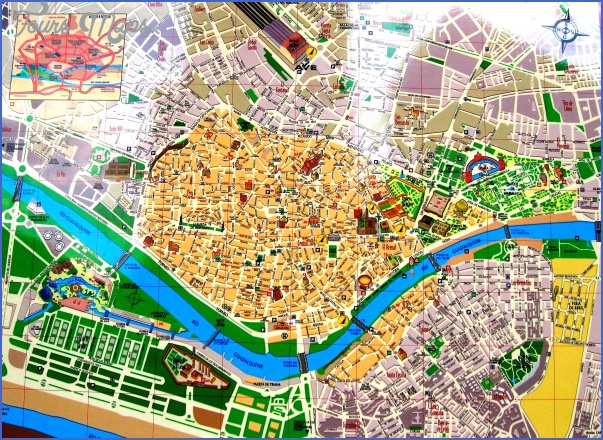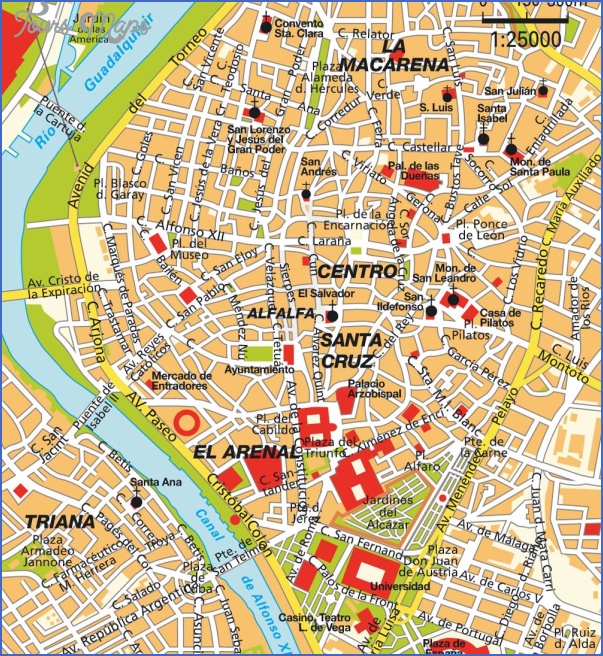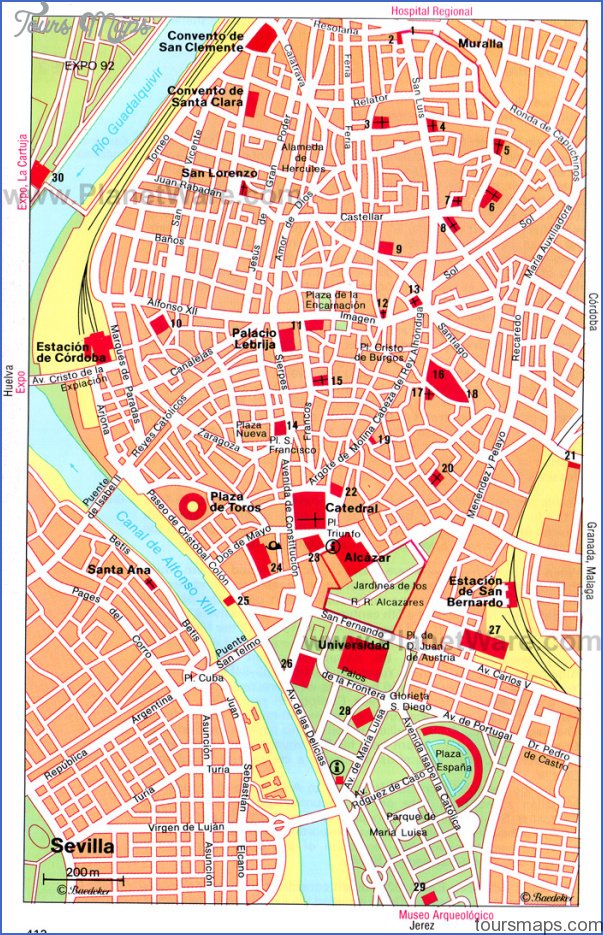Seville Map
FOOD
Seville, which claims to be the birthplace of tapas, keeps its cuisine light. Tapas bars cluster around Plaza San Martin and along Calle San Jacinto. Popular venues for el tapeo (fapas-barhopping) are Barrio Santa Cruz and El Arenal. Locals imbibe Seville’s own Cruzcampo beer, a light, smooth pilsner. Mercado del Arenal, near the bullring on C. Pastor y Leandro, has fresh meat and produce. (Open M-Sa 9am-2pm.) For a supermarket, try %Dia, C. San Juan de Avila, near El Corte Ingles. (Open M-F 9:30am-2pm and 6:30-9pm, Sa 9am-lpm.)
Restaurante-Bar El BaratilloCasa Chari, C. Pavia 12 (954 22 96 51), on a tiny street off C. Dos de Mayo. Hospitable owner will help you practice your Spanish. Order at least an hour in advance for the tour-de-force: Homemade paella (vegetarian options available) with a jar of wine, beer, orsangria (2 jars ‚18). Menu ‚4-9. Open M-F 10am-10pm, Sa 10am-5pm; stays open later when busy. li Habanita Bar Restaurant, C. Golfo 3 (606 71 64 56; www.andalunet.comhabanita), on a tiny street off of C. Perez Galdos, next to PI. Alfalfa. Exquisite Cuban fare, including yucca and tostones (fried bananas). Full or half-entree ‚4.80-10. Open daily 12:30-4:30pm and 8pm-12:30am. Closed Su night. MCV. O if San Marco, C. Meson del Moro 6 ( 954 21 43 90), several blocks from the cathedral. Amazing pizzas, pastas, and Italian desserts in an 18th-century house and 17th-century Arab baths. Other locations in equally impressive settings at C. Betis 68 (954 28 03 10), and at C. Santo Domingo de la Calzada 5 (954 58 33 43). Entrees ‚5-7.50. Open Su and Tu-Sa l:15-4:30pm and 8:15pm-12:30am. MCV.
Ancha de la Feria, C. Feria 61 (954 90 97 45). Snack on delicious homemade tapas in this bright and airy local barrestaurant. Old sherry barrels line the walls and ceiling. Tapas ‚1.50-2. Raciones from ‚4. Great menu del dla ‚5.80, served M-F afternoons only. Open Tu-Sa 9am-4pm and 9pm-lam, Su 9am-4pm. O
Cafe-Bar Campanario, C. Mateos Gago 8 (954 56 41 89), lk block from the cathedral, on the right. Newer and shinier than most tapas bars. Mixes the best (and strongest) jugs of sangria around (V2L ‚7.30,1L ‚9.70). Tapas ‚1.50-2. Raciones ‚6-8.40. Open daily 10:30am-12:30am. 0
Restaurante Coello, C. Doncella 8 (954 42 10 82), on a tiny street off C. Santa Maria la Blanca. Dine in the bright yellow interior or outside on the narrow cobblestone street. Splurge on their delicately prepared a la carte meat and fish entrees (‚10-15). Menu ‚8. Appetizers ‚4-10. Open daily noon-midnight. MCV.
Cafe Caceres, C. San Jose 24 (954 21 51 31). The closest thing to a buffet-style breakfast in Seville. Choose from a spread of cheeses, jams, countless condiments, fresh orange juice, and numerous omelets. Desayuno de la casa (orange juice, coffee, ham, eggs, and toast) ‚4.50. Open M-Sa 7:30am-8pm, Su 7:30am-4pm. O
SIGHTS
The tourist office has a detailed map of the winding alleys, wrought-iron gates, and courtyards of Santa Cruz. Its monuments form the most vivid images in the mosaic that is Seville, and harken its history as the one-time judena.
CATEDRAL. Legend has it that in 1401 the reconquistadores wished to demonstrate their religious fervor by constructing a church so great, they said, that those who come after us will take us for madmen. With 44 individual chapels, the cathedral of Seville is the third largest in the world, after St. Peter’s Basilica in Rome and St. Paul’s Cathedral in London, and the biggest Gothic edifice ever constructed. Not surprisingly, it took more than a century to build. In 1401, a 12th-century Almohad mosque was destroyed to clear space for the massive cathedral. All that remains is the Patio de Los Naranjos, where the faithful would wash before prayer, the Puerta del Perdon entryway from C. Alemanes, and the famed La Giralda minaret built in 1198. The tower and its twins in Marrakesh and Rabat are the oldest and longest-surviving Almohad minarets. There are 35 ramps inside leading to the tower’s top that once allowed the muezzin to climb up on his horse for the call to prayer; today, they enable tourists to take pictures.
In the center of the cathedral, the Capilla Real, built in Renaissance style, stands opposite choirstalls made of mahogany recycled from a 19th-century Austrian railway. The Eretablo mayor, one of the largest in the world, is a golden wall of intricately wrought saints and disciples. Nearby is the Sepulcro de Cristobal Colon (Columbus’s tomb), which supposedly holds the explorer’s remains, brought back to Seville after Cuba’s independence in 1902 (the tomb had been located in Havana’s cathedral). The black-and-gold pallbearers represent the eternally grate-
ful monarchs of Castilla, Leon, Aragon, and Navarra. Farther on and to the right stands the Sacristi’a Mayor (treasury), which holds gilded panels of Alfonso X el Sabio, done by Juan de Arefe, works by Ribera and Murillo, and a glittering Corpus Christi icon, La Custodia Processional. A small, disembodied head of John the Baptist eyes visitors who enter the gift shop. It overlooks keys presented to the city of Seville by Jewish leaders after King Fernando III ousted the Muslims in 1248. In the northwest comer of the cathedral lies the architecturally stunning Sala de Las Columnas. Each year, expenses on the cathedral alone total over ‚3.8 million. (s954 21 49 71. Entrance by the PI. de la Virgen de los Reyes. Open M-Sa llam-5pm, Su 2:30-6pm. Last entrance lhr. before closing. ‚6, seniors and students ‚1.50. Under-12 and Su free. Mass held in the Capilla Real M-Sa 8:30,10am, noon; Su 8:30,10,11am, noon, lpm.)
ALCAZAR. The oldest European palace still used as a private residence for royals, Seville’s Alcazar is nothing short of magnificent. Like the Alhambra in Granada, Seville’s Alcazar has Moorish architecture and gardens, and although the Alhambra gets more press, the Alcazar is equally, if not more, impressive. Constructed by the Moors in the 7th century, the palace was embellished greatly during the 15th centuiy and now displays an interesting mix of Moorish and Christian architecture, seen most prominently in the mudejar style of many of the arches, tiles, and ceilings. Ferdinand and Isabella of Portugal are the palace’s most well-known former residents; Carlos V also lived here and married his cousin Isabella of Portugal in the Salon Techo Carlos V. Visitors enter through the Patio de la Monteria, directly across from the intricate Almohad facade of the Moorish palace. Through the archway lie the Arabic residences, including the Patio del Yeso, used by Moorish governors before the palace itself was even built, and the exquisitely carved Patio de las Muiiecas (Patio of the Dolls), so named because of miniature faces carved into the bottom of one of the room’s pillars. Originally a courtyard, the Patio de las Muiiecas served as a private area for Moorish kings, with an escape path (no longer in existence) so that in case of an attack the king would not have to cross the open space. Of the Christian additions, the most notable is the Patio de las Doncellas (Patio of the Maids). Court life in the Alcazar revolved around this colonnaded quadrangle, which is encircled by archways adorned with glistening tile-work. The golden-domed Salon de los Embajadores (Embassadors’ Room) is allegedly the site where Ferdinand and Isabella welcomed Columbus back from the New World. Several beautiful silk tapestries adorn the walls of the appropriately named Sala de Tapices. The son of Ferdinand and Isabella, Prince Juan, was bom in the red-and-blue tiled Cuarto del Principe; the room was named for him after his untimely death, supposedly of a broken heart.
The private residences upstairs, the official home of the king and queen of Spain, and where they stay when they visit Seville, have been renovated and redecorated throughout the centuries; most of the furniture today dates from the 18th and 19th centuries. These residences are accessible only by 25min. guided tours (see info below). Peaceful gardens stretch from the residential quarters in all directions. (PI. del Triunfo 7. s954 50 23 23. Open Tu-Sa 9:30am-7pm, Su 9:30am-5pm. ‚5. Students, handicapped, residents, over-65, and under-16 free. Tours of the upper palace living quarters every 30min. June-Juiy 10am-l:30pm, Aug.-May 10am-l:30pm and 3:30-5:30pm; ‚3. Fifteen people max. per tour, so buy tickets in advance. Worthwhile audioguides give anecdotes, historical info, and a clearly marked route through the complex; ‚3.)
MUSEO PROVINCIAL DE BELLAS ARTES. Cobbled together from decommissioned convents in the mid-1800s, this museum contains Spain’s finest collection of works by painters of the Sevillana School, notably Murillo, Valdes Leal, and Zurbaran, as well as El Greco and Dutch master Jan Breughel. Although the art (displayed more or less chronologically as well as thematically) is heavily biased toward religious themes, later works include some landscape paintings and portraits depicting Seville, its environs, and residents. The building itself is a work of art; take time to sit in the shady gardens. (PI. del Museo 9. s954 22 07 90. Open Tu 3-8pm, IfV-Sa 9am-8pm, Su 9am-2pm. ‚1.50. EU citizens free.)
PLAZA DE TOROS DE LA REAL MAESTRANZA. Home to one of the two great bullfighting schools (the other is in Ronda), Plaza de Toros de la Real Maestranza fills to capacity for weekly fights and the 13 corridas of the Feria de Abril. The museum inside has costumes, paintings, and antique posters. (Open non-bullfight days 9:30am-7pm, bullfight days 9:30am-3pm. Tours every 20min. ‚4.)
BARRIO DE SANTA CRUZ. King Fernando III forced Jews fleeing Toledo to live in the Barrio de Santa Cruz, now a neighborhood of weaving alleys and courtyards. Beyond C. Lope de Rueda, off C. Ximenez de Enciso, is the Plaza de Santa Cruz. South of the plaza are the Jardines de Murillo, a shady expanse of shrubbery. PI. Santa Cruz’s church houses the grave of the artist Murillo, who died after falling from a scaffold while painting ceiling frescoes in a Cadiz church. Nearby, Iglesia de Santa Maria la Blanca, built in 1391, contains Murillo’s Last Supper. (Church open M-Sa 10-1 lam and 6:30-8pm, Su 9:30am-2pm and 6:303pm. Free.)
LA MACARENA. This area northwest of El Centro is named for the Virgin of Seville. A stretch of 12th-century murallas (walls) runs between the Pta Macarena and the Pta. Cordoba on the Ronda de Capuchinos. At the west end is the Basilica Macarena, whose venerated image of La Virgen de la Macarena is paraded through town during Semana Santa. A treasury within glitters with the virgin’s jewels and other finery. (C. Biquer 1. Basilica open M-Sa 9am-2pm and 5-9pm, Su 9:30am-2pm and 5-9pm. Free. Treasury open daily 9:30am-2pm and 5-8pm. ‚3, students and over-65 ‚1.50. Sa free.) Toward the river is the Iglesia de San Lorenzo y Jesus del Gran Poder, with Montanes’s remarkably lifelike sculpture El Cristo del Gran Poder. Worshipers kiss Jesus’s ankle through an opening in the bulletproof glass for luck. Semana Santa culminates in a procession honoring the statue. (PI. San Lorenzo. Open M-Th 8am-l:30pm and 6-9pm, F 7:30am-10pm, Sa-Su 8am-2pm and 6-9pm. Free.)
Seville Map Photo Gallery
Maybe You Like Them Too
- Explore Sasbach, Germany with our Interactive Map
- Explore Nevestino, Bulgaria with this Detailed Map
- Explore Pulau Sebang Malaysia with this Detailed Map
- Explore Southgate, Michigan with this detailed map
- Explore Les Accates, France with this Detailed Map

